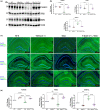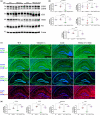A partial reduction of VDAC1 enhances mitophagy, autophagy, synaptic activities in a transgenic Tau mouse model
- PMID: 35801276
- PMCID: PMC9381918
- DOI: 10.1111/acel.13663
A partial reduction of VDAC1 enhances mitophagy, autophagy, synaptic activities in a transgenic Tau mouse model
Abstract
Alzheimer's disease (AD) is the most common cause of mental dementia in the aged population. AD is characterized by the progressive decline of memory and multiple cognitive functions, and changes in behavior and personality. Recent research has revealed age-dependent increased levels of VDAC1 in postmortem AD brains and cerebral cortices of APP, APPxPS1, and 3xAD.Tg mice. Further, we found abnormal interaction between VDAC1 and P-Tau in the AD brains, leading to mitochondrial structural and functional defects. Our current study aimed to understand the impact of a partial reduction of voltage-dependent anion channel 1 (VDAC1) protein on mitophagy/autophagy, mitochondrial and synaptic activities, and behavior changes in transgenic TAU mice in Alzheimer's disease. To determine if a partial reduction of VDAC1 reduces mitochondrial and synaptic toxicities in transgenic Tau (P301L) mice, we crossed heterozygote VDAC1 knockout (VDAC1+/- ) mice with TAU mice and generated double mutant (VDAC1+/- /TAU) mice. We assessed phenotypic behavior, protein levels of mitophagy, autophagy, synaptic, other key proteins, mitochondrial morphology, and dendritic spines in TAU mice relative to double mutant mice. Partial reduction of VDAC1 rescued the TAU-induced behavioral impairments such as motor coordination and exploratory behavioral changes, and learning and spatial memory impairments in VDAC1+/- /TAU mice. Protein levels of mitophagy, autophagy, and synaptic proteins were significantly increased in double mutant mice compared with TAU mice. In addition, dendritic spines were significantly increased; the mitochondrial number was significantly reduced, and mitochondrial length was increased in double mutant mice. Based on these observations, we conclude that reduced VDAC1 is beneficial in symptomatic-transgenic TAU mice.
Keywords: Alzheimer's disease; autophagy; hexokinases; mitochondria; mitochondrial biogenesis; mitophagy; oxidative stress; voltage-dependent anion channel 1.
© 2022 The Authors. Aging Cell published by Anatomical Society and John Wiley & Sons Ltd.
Conflict of interest statement
The authors declare no conflict of interest.
Figures








Similar articles
-
Reduced VDAC1, Maintained Mitochondrial Dynamics and Enhanced Mitochondrial Biogenesis in a Transgenic Tau Mouse Model of Alzheimer's Disease.Int J Mol Sci. 2022 Aug 2;23(15):8561. doi: 10.3390/ijms23158561. Int J Mol Sci. 2022. PMID: 35955694 Free PMC article.
-
A partial reduction of Drp1 improves cognitive behavior and enhances mitophagy, autophagy and dendritic spines in a transgenic Tau mouse model of Alzheimer disease.Hum Mol Genet. 2022 Jun 4;31(11):1788-1805. doi: 10.1093/hmg/ddab360. Hum Mol Genet. 2022. PMID: 34919689 Free PMC article.
-
Abnormal interaction of VDAC1 with amyloid beta and phosphorylated tau causes mitochondrial dysfunction in Alzheimer's disease.Hum Mol Genet. 2012 Dec 1;21(23):5131-46. doi: 10.1093/hmg/dds360. Epub 2012 Aug 27. Hum Mol Genet. 2012. PMID: 22926141 Free PMC article.
-
Is the mitochondrial outermembrane protein VDAC1 therapeutic target for Alzheimer's disease?Biochim Biophys Acta. 2013 Jan;1832(1):67-75. doi: 10.1016/j.bbadis.2012.09.003. Epub 2012 Sep 17. Biochim Biophys Acta. 2013. PMID: 22995655 Free PMC article. Review.
-
Amyloid Beta and Phosphorylated Tau-Induced Defective Autophagy and Mitophagy in Alzheimer's Disease.Cells. 2019 May 22;8(5):488. doi: 10.3390/cells8050488. Cells. 2019. PMID: 31121890 Free PMC article. Review.
Cited by
-
Distinct neuronal vulnerability and metabolic dysfunctions are characteristic features of fast-progressing Alzheimer's patients with Lewy bodies.J Biol Chem. 2025 Apr;301(4):108396. doi: 10.1016/j.jbc.2025.108396. Epub 2025 Mar 10. J Biol Chem. 2025. PMID: 40074078 Free PMC article.
-
VDAC1 Inhibition Protects Against Noise-Induced Hearing Loss via the PINK1/Parkin Pathway.CNS Neurosci Ther. 2025 Apr;31(4):e70410. doi: 10.1111/cns.70410. CNS Neurosci Ther. 2025. PMID: 40285415 Free PMC article.
-
Is the Voltage-Dependent Anion Channel a Major Player in Neurodegenerative Diseases?Int J Mol Sci. 2025 Jun 26;26(13):6138. doi: 10.3390/ijms26136138. Int J Mol Sci. 2025. PMID: 40649921 Free PMC article. Review.
-
Research Progress of Mitophagy in Alzheimer's Disease.Curr Alzheimer Res. 2024;20(12):827-844. doi: 10.2174/0115672050300063240305074310. Curr Alzheimer Res. 2024. PMID: 38482617 Review.
-
Organelle perturbation in Alzheimer's disease: do intracellular amyloid-ß and the fragmented Golgi mediate early intracellular neurotoxicity?Front Cell Dev Biol. 2025 Apr 15;13:1550211. doi: 10.3389/fcell.2025.1550211. eCollection 2025. Front Cell Dev Biol. 2025. PMID: 40302938 Free PMC article. Review.
References
-
- Abu‐Hamad, S. , Zaid, H. , Israelson, A. , Nahon, E. , & Shoshan‐Barmatz, V. (2008). Hexokinase‐I protection against apoptotic cell death is mediated via interaction with the voltage‐dependent anion channel‐1: Mapping the site of binding. The Journal of Biological Chemistry, 283(19), 13482–13490. 10.1074/jbc.M708216200 - DOI - PubMed
-
- Azoulay‐Zohar, H. , Israelson, A. , Abu‐Hamad, S. , & Shoshan‐Barmatz, V. (2004). In self‐defence: Hexokinase promotes voltage‐dependent anion channel closure and prevents mitochondria‐mediated apoptotic cell death. The Biochemical Journal, 377(Pt 2), 347–355. 10.1042/BJ20031465 - DOI - PMC - PubMed
Publication types
MeSH terms
Substances
Grants and funding
LinkOut - more resources
Full Text Sources
Medical
Miscellaneous

